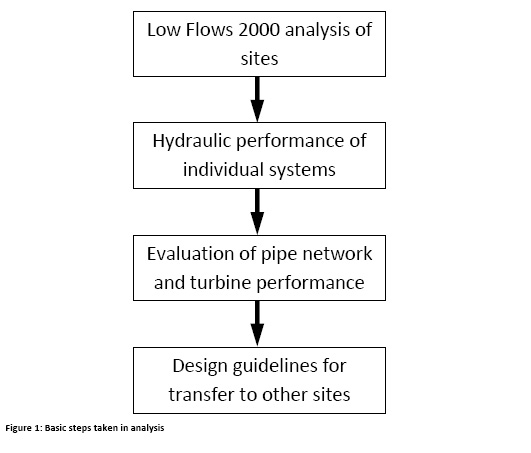Small Scale Hydro: Novel Approaches to Generation & Transmission

Strategy
The goal of the investigation into to the concept of a combined pressure header is an analysis of the hydraulic behaviour of the pipe network system and an economic evaluation of potential combined schemes. The group identified 4 distinct stages on how to perform such an analysis, which are highlighted if Figure 1.
1 - Flow Data Capture
In order to perform any kind of mathematical analysis we firstly required accurate flow duration data for each of the potential corries. As all the schemes under consideration would have zero storage capacity, the data collated needed to be monthly to ensure that analysis would be accurate and could represent genuine seasonal variations in flow rates. The data was collated using Low Flows 2000 software which provides monthly flow duration curves corresponding to rainfall catchment areas. A full description of the software and how it was used can be found here
2 - Mathematical Modelling of Schemes
The project required the mathematical modelling of each of the hydro schemes in order to calculate the amount of energy that would be theoretically captured throughout a year of operation. This involved combining the flow duration data for each of the schemes with various calculations and assumptions. The group initially evaluated what would be required in order to define the hydraulic performance of the potential hydro schemes. There were a number of commercially available software programs that can mathematically model pipe performance. However, from the options available, the group decided to carry out the mathematical analysis using Microsoft Excel in a bid to strengthen our own understanding of the project and develop a downloadable tool for use in similar calculations.
3 – Evaluate Turbine and pipeline performances
With a working mathematical model a sensitivity analysis can be carried out to evaluate outcomes from different configurations of schemes and ascertain the potential benefits/shortcomings of combining the water flows to a single point of generation. The case study used flow data from 3 corries from the Glen Almond site along with indicative financial quotes from various contractors.
4- Develop transferrable design guidelines/recommendations
The group decided that, having conducted the analysis and obtained results, it would be of benefit to present the conclusions in the form of general guidelines and recommendations that may have potential application for future developments.
The investigation strategy was initially used to evaluate the performance of individual systems, details of which can be found here.
